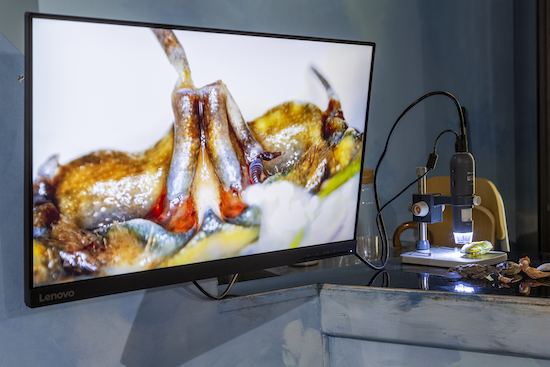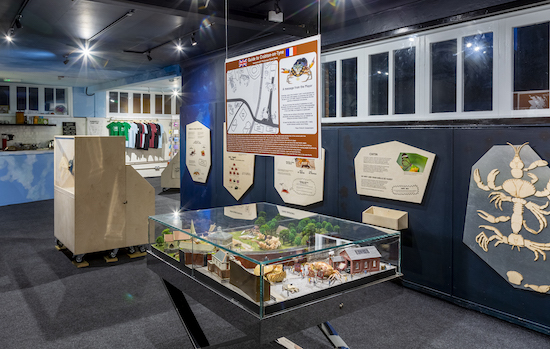Photo by Sheradon Dublin
In 1862, Margate fisherman Thomas Gaskell made an incredible catch. From beneath the waves came a giant crab, two-and-a-half metres in length. Although the creature might have made Gaskell rich, he instead took it to live in his cottage, where it reportedly ate chopped eels and “showed a strange interest in the world of humans, grasping and ungrasping things in an attempt to learn”.
This blissful high point of human-decapod domestic relations was sadly doomed from the start. What followed is a sad and gruesome tale, involving angry mobs, a travelling freak show – and, ultimately, the death and dismemberment of a cruel and drunken circus master.
It is an incredible story. Can any of it be true? If it isn’t, what kind of untruth is it? What even is truth, anyway? These questions might initially seem beyond the remit of the Crab Museum, but they are in fact a central part of the attraction’s ambitious approach to entertainment and education.
Promising a “satisfyingly baffling day out”, the museum opened last year in a former pie factory in the Old Town of Margate. Although the team claim not to be experts, displays are packed with fascinating nuggets of information, and the staff are fonts of knowledge about crabs and associated topics – which, according to them, includes all scientific, political, and cultural knowledge, and a lot more asides.
“It’s a proof of concept that everything is related to each other. All knowledge is entwined. Like, intrinsically,” says Ned Suesat-Williams, one of three directors alongside his brother Bertie, and Chase Coley. “And also crabs are cool and funny looking. I stand by that, that’s a hill I will die on.”

Photo by Sheradon Dublin
Expertly wielding the twin claws of scepticism and the holistic perspective, the museum gently pushes visitors in a clear direction – the realisation that our current economic and political system allows, enables and profits from the destruction of precious natural systems, and that it can only be stopped by enlightened young minds fighting for a different way of doing things.
The museum gets to work quickly as you step into the entrance corridor, which doubles as a timeline of Earth’s history – one millimetre is a million years, and human history is in the final fraction of a millimetre. Upstairs, written displays are filled with factoids, jokes and philosophical conundrums, while exhibits are mainly focused around now-empty exoskeletons.
A horseshoe crab – not really a crab, apparently, or even a crustacean – is fixed to a metal board, simulated milky-blue blood draining into a kilner bottle. The liquid is used to test new medicines, the display tells us, flagging dangerous toxins and helping save millions of human lives in the process.
In the centre of the room is a diorama of ‘Crabton-on-Tyne’, using crabs from around the world in a tumultuous tableau of class warfare in 1926 England. A common decorator crab (Schizophrys aspera) is a penny-pinching paper mill boss, while a fascist moon crab (Matuta lunaris) attacks striking workers.
Perhaps the main attraction is the giant claw of Thomas Gaskell’s ill-fated crustacean companion, although the size of the massive nipper pales in comparison with the elaborate yarn spun around it.

Photo by Sheradon Dublin
A circuit of the main room ends at the Crustacean Identification Station, where a member of the team is often found highlighting the ocular peduncle of a local specimen, or assisting amateur carcinologists with their own finds from Margate Main Sands. The fragments of carapace, insects and other assorted marine life inspire wide-ranging mini-lectures and sprawling, tangential conversations, frequently returning to climate change and its political and economic context.
The team also instigates conversation with an engaging, meme-centric online presence, with gently subversive anticapitalist takes on the monarchy, consumerism and more, and in-depth exploration of topics as diverse as the effect of noise on seagrass, microplastics and climate anxiety.
“The contradiction is, the future is quite bleak in some ways,” says Bertie. “If you terrify people, they become apathetic. They’re like: ‘The whole world is going to end, what’s the point of me doing anything about it?’… The alternative is you kid everybody on that everything’s fine, and that capitalism and big business is going to find a way to solve climate change. And then also nothing gets done.
“So actually, any kind of climate action has to go in between, like it’s sort of apocalyptic on one side and tokenistic on the other side, there has got to be something in between. And we think humour is quite a good way of doing that, because it avoids the terror.”
As the effects of the climate emergency become increasingly evident, the museum’s mission seems more important than ever. Crabs provide a useful ‘in’ to conversations with locals and visitors who have their own experiences discovering the creatures in nearby rockpools, says Ned, showing what is at risk from the environmental carnage of unfettered capitalism.
The approach is particularly important for younger visitors. "”If you inspire a child into thinking that crabs are cool, you’ve increased the chances of them being into science like tenfold,” he says. “The longer that the museum has been going on, the more we’ve overheard conversations from very young children, teenagers as well, saying ‘Science can be interesting.’ At a very base level, if we can play a small part in making a couple of scientists then the whole project is worth it.”
The museum celebrates its first birthday with a party this Saturday (22 October) and a ‘Crabaret’ for the Climate Emergency Fund next Saturday (29 October), featuring locally based musicians including soul jazz keyboardist and composer Jessica Lauren, and Falle Nioke, a singer and percussionist from Guinea. A fundraiser has also been set up to help it grow and to support its admirable policy of free entry.
Local people quickly welcomed the attraction, the brothers say, and frequently donate crab-related paraphernalia. One prize specimen was even wedged through the letterbox, soon finding itself in regular use at the Crustacean Identification Station.
Conversation there has turned to the process of carcinisation, by which crabs have repeatedly evolved on separate branches of the evolutionary tree. Could this mean they represent some sort of biological ideal?
Not exactly. “In many ecological niches, there is space for a crab,” Ned adds. “They represent resilience in many ways. They shed their shells and are born anew, they are masters of sea and land.”
An inspiration to all climate-concerned citizens, as we venture sideways into an uncertain future.


